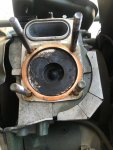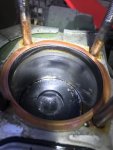stoneburner
Member
- 33
- 12
- 8
- Location
- Athens, Ohio
So, I've had my MEP016D for nearly 10 years. It has been with me through a derecho and countless other power outages. got it with 1 hour on the meter (if I remember correctly). It has always started on the second pull, even in freezing weather...until now.
I've kept up with maintenance, and it's currently at 120 hours, last time it was run was in July or August this year. Ran started and ran perfectly fine at that time.
Went to start last week and nothing. I was exhausted after fighting for 1/2 hour to start. Since then, I have changed the fuel filter, verified fuel flow/pump operation, tested the injector pattern (good), nothing. Air filter is still good. I even tried an ether shot or two. Not even a sputter.
Then, I realized that I didn't almost break my wrist when I forgot to hit the decompression valve several times. In fact, no difference between compression valve/no compression valve. Diesel mechanic neighbor suggested pouring cap full of oil directly into the cylinder to see if I had a "dry" piston. No improvement in compression. I'm about ready to shoot this thing with my M1 Garand. But, I've been down that road before and I always regret taking my frustrations out on my equipment. Unless it deserves it. I know this HAS to be something stupidly simple. Maybe? Only 120 hours. What could be wrong? I'm leaning toward valve(s) being carbed up, but before I take the cylinder head off, I wanted to see if anyone else has had this sort of thing happen with their Yanmar L70AE diesel. And what resolved the problem?
Thanks!
Mike
I've kept up with maintenance, and it's currently at 120 hours, last time it was run was in July or August this year. Ran started and ran perfectly fine at that time.
Went to start last week and nothing. I was exhausted after fighting for 1/2 hour to start. Since then, I have changed the fuel filter, verified fuel flow/pump operation, tested the injector pattern (good), nothing. Air filter is still good. I even tried an ether shot or two. Not even a sputter.
Then, I realized that I didn't almost break my wrist when I forgot to hit the decompression valve several times. In fact, no difference between compression valve/no compression valve. Diesel mechanic neighbor suggested pouring cap full of oil directly into the cylinder to see if I had a "dry" piston. No improvement in compression. I'm about ready to shoot this thing with my M1 Garand. But, I've been down that road before and I always regret taking my frustrations out on my equipment. Unless it deserves it. I know this HAS to be something stupidly simple. Maybe? Only 120 hours. What could be wrong? I'm leaning toward valve(s) being carbed up, but before I take the cylinder head off, I wanted to see if anyone else has had this sort of thing happen with their Yanmar L70AE diesel. And what resolved the problem?
Thanks!
Mike



